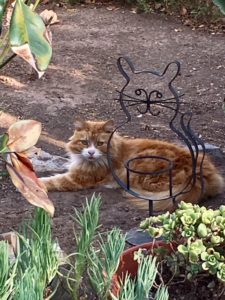 Can a tiger change its stripes? So to speak, yes. If you’ve had cats long you know that they can change their habits and offer little surprises over time. The cat or kitten you bring home isn’t always the cat who shares your house eight or ten years later.
Can a tiger change its stripes? So to speak, yes. If you’ve had cats long you know that they can change their habits and offer little surprises over time. The cat or kitten you bring home isn’t always the cat who shares your house eight or ten years later.
Our Himalayan, Katy is an example of this. From the time she was a kitten, she hid when the doorbell rang and would come out only after our guests had left. When she was fifteen, however, we noticed that the doorbell no longer elicited that response from Katy. I don’t know if her hearing was failing, she was too tired to leave her napping spot when guests arrived, or maybe she was experiencing age-appropriate memory loss, but she no longer ran from the room and hid. She began to allow (even invite) visitors  to pet her and sometimes she’d even greet them as they came in.
to pet her and sometimes she’d even greet them as they came in.
Cats that spend their younger life enjoying time outdoors, will sometimes become lap cats who rarely leave the house. An aloof cat might become a cuddle-bug and insist on regular lap time. Lily will be ten soon and she just started purring last year. Until then, I had never heard that little torbie purr.
 We’ve all experienced a cat who suddenly wouldn’t take her medicine or let you clip her claws or brush her. That’s usually because of an unpleasant occurrence—the brush pulled her fur, something happened to scare her or make her feel uncomfortable during a claw-trimming. But I find it most interesting when a cat suddenly develops a new habit or begins pursuing a new activity as an adult. It’s rather charming. Such as Lily’s latest pastime—bringing me my slipper socks. Now, instead of her stuffed toys spread across the floor all the time, it’s my heavy socks I wear in winter that decorate our house. How nice of her to think of me.
We’ve all experienced a cat who suddenly wouldn’t take her medicine or let you clip her claws or brush her. That’s usually because of an unpleasant occurrence—the brush pulled her fur, something happened to scare her or make her feel uncomfortable during a claw-trimming. But I find it most interesting when a cat suddenly develops a new habit or begins pursuing a new activity as an adult. It’s rather charming. Such as Lily’s latest pastime—bringing me my slipper socks. Now, instead of her stuffed toys spread across the floor all the time, it’s my heavy socks I wear in winter that decorate our house. How nice of her to think of me.
Cats can be trained or conditioned, of course, but some cats seem to retrain themselves to open a cabinet door, begin napping in a closet, develop a fascination for something they never paid attention to before (sheets of paper coming from the fax machine or printer, earrings hanging on your jewelry tree, a potted plant, etc.). Max, our snowshoe-type cat, discovered how fun it was and how much I’d react when he’d push my pen off my desk—usually into the wastebasket. He taught Lily to hide under the bed covers when she was frightened. My heart breaks for her now when something scares her—thunder, a noisy truck on our street, the gardeners, etc—and she has to crawl under the blankets alone. I believe she started sharing that space with Max for support and comfort. The two cats didn’t have a close relationship, but they became hiding buddies in times of stress. Sweet.
cats seem to retrain themselves to open a cabinet door, begin napping in a closet, develop a fascination for something they never paid attention to before (sheets of paper coming from the fax machine or printer, earrings hanging on your jewelry tree, a potted plant, etc.). Max, our snowshoe-type cat, discovered how fun it was and how much I’d react when he’d push my pen off my desk—usually into the wastebasket. He taught Lily to hide under the bed covers when she was frightened. My heart breaks for her now when something scares her—thunder, a noisy truck on our street, the gardeners, etc—and she has to crawl under the blankets alone. I believe she started sharing that space with Max for support and comfort. The two cats didn’t have a close relationship, but they became hiding buddies in times of stress. Sweet.
What habits or activities have your cats changed as they’ve aged?





